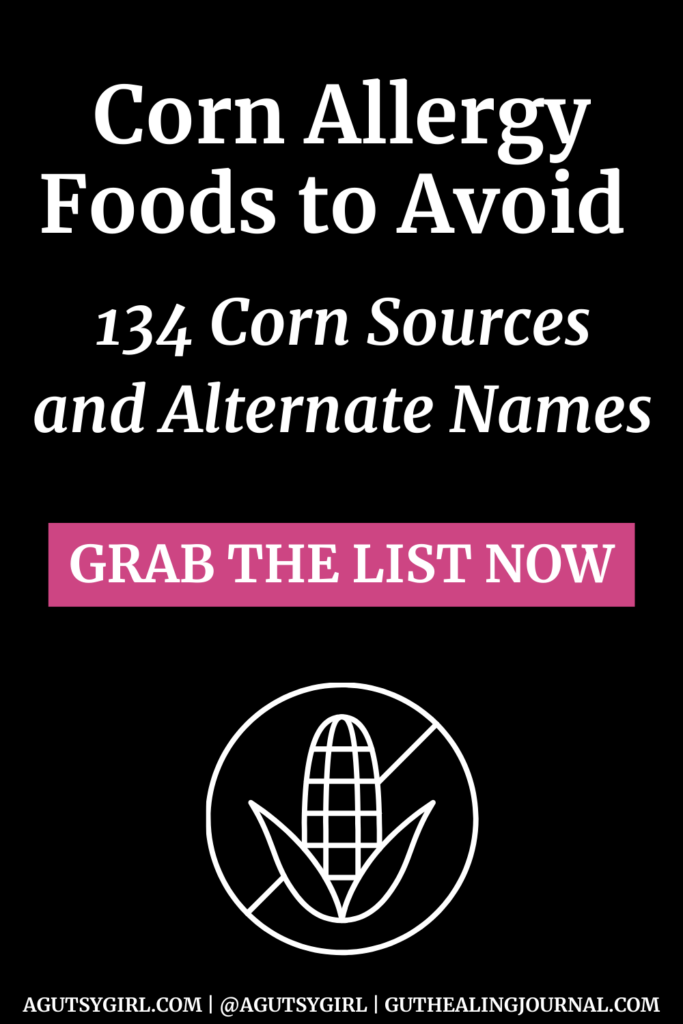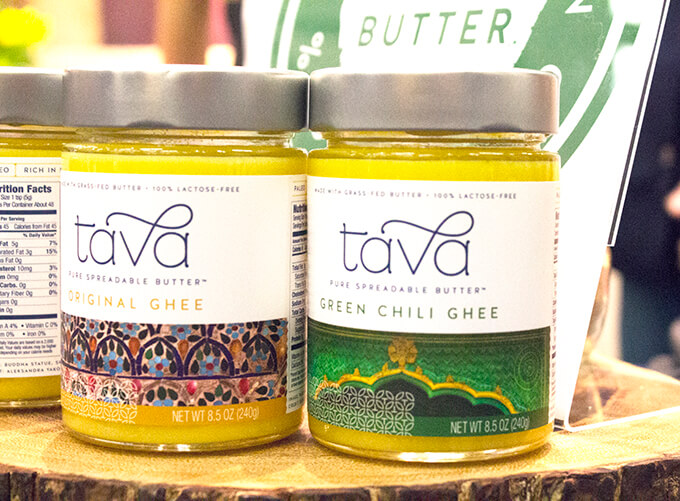Do you have a corn allergy or even corn food intolerance and you’re looking for which corn allergy foods to avoid?
In case you thought corn consisted only of corn-on-the cob, I put together a list of 134 corn sources and alternate names to show you otherwise – corn allergy foods to avoid.
The first list I ever made like this was a list of 192 sugar sources and alternate names.
And, in fact, there is a ton of information regarding food allergens and different food sources that could cause allergy and intolerance symptoms in A Gutsy Girl’s Bible: a 21-day approach to healing the gut.
With food allergies and intolerances increasing, it’s crucial for me to share these lists with you so that you have them handy for gut health and gut-healing toolbox.
Why Create These Lists?
First, just like sugar, not all corn food products are evil.
The reason I put together these lists is to show that corn products are so many things beyond the standard corn kernel. Because many people have an intolerance or allergy to corn or corn derivatives, a list like this could be very useful.
That said, a lot (not all) of corn and corn-based products are not good. Corn consistently stays on the top 10 list of GMO crops. And research shows the link between GMO foods and digestion.
Take that for what it’s worth to you.
For me personally, it was super important on my journey towards healing my gut. While I never had a corn allergy, I did suspect some minor intolerances to corn.
And, not only that, but some corn products are high-FODMAP, which can exacerbate gut symptoms. Take for instance even corn-on-the cob, which is a commonly consumed corn product for those of us in the Midwest during summer.

Taken from A Gutsy Girl’s Reasonable SIBO PDF guide that you can find + download HERE.
And second
…if you’re following any sort of elimination diet, then you already know how I feel about recording an ingredient(s) and ingredients list.
In this case, using these lists in conjunction with the journal will be ultra-helpful.
What is a Corn Allergy?
When you have a corn allergy – also known as a maize allergy – it indicates immune responses to corn or its products, the main culprit of these symptoms is a protein called zein.
Zein is a protein in corn that can trigger a corn allergy reaction.
Zein is the major storage protein (accounting for 35–65%) in corn and has been found exclusively in the endosperm (Luo and Wang, 2012)
Symptoms of a Corn Allergy
Corn allergy symptoms can show up as:
- Skin reactions: Itchy skin, hives, eczema, or swelling.
- Gastrointestinal symptoms: Nausea, vomiting, abdominal pain, diarrhea, or bloating.
- Respiratory issues: Runny or stuffy nose, sneezing, coughing, wheezing, shortness of breath, or asthma.
- Oral allergy syndrome: Itchy or tingling sensation in the mouth, throat, or lips.
- Anaphylaxis: In rare cases, a severe and potentially life-threatening allergic reaction may occur, involving symptoms such as difficulty breathing, rapid heartbeat, drop in blood pressure, and loss of consciousness.
These symptoms can range from mild to severe, depending on the person.
For the purposes of this website, we are focused mostly on those GI symptoms. In particular, I hear so many complain of massive bloating from corn. You might be experiencing that today.
Severe Cases of Corn Allergies
When you have a severe case of a corn allergy that means you experience an anaphylactic reaction to corn.
If, through testing, you determine your allergy is severe, the number one thing you can do is to completely avoid corn at all costs, not only following a corn-free diet, but also being cognizant of cross contamination and possibly even cross reactors.
To learn about the differences between cross contamination, cross reaction and cross contact, read THIS article.
While cross contamination, cross reaction and cross contact are not the same things, they can all play a part in your corn reactions, depending on the severity.
Next, you will always need to be prepared in the case that you do come into contact with corn and have a severe allergic reaction.
The best way is by keeping an EpiPen close by for emergency situations, as it is the only way to treat an anaphylactic reaction. You will need to carry one with you and know how to use it.
Anaphylaxis is a medical emergency, so you’ll need to go to the emergency room or call 911 if it happens.
Does corn cross-react with pollen?
Yes, corn can cross-react with pollen; there have been many cases in which individuals allergic to pollen have also reacted to corn.
Maize has been found to cross-react with other cereals, such as rice, wheat, barley, etc. Besides this, maize has also shown to cross-react with fruits, such as peach, cherry, cowpea, apricot, grapes as well as pollens, such as grass and Platanus pollens.
What’s the Difference Between a Corn Allergy and Corn Intolerance?
Remember, an allergy and intolerance are not the same things.

Allergic reactions to food
A food allergy is an “immune system reaction that occurs soon after eating a certain food. Even a tiny amount of the allergy-causing food can trigger signs and symptoms such as digestive problems, hives or swollen airways.”
It may or may not cause an anaphylactic reaction.
The most common food allergy signs and symptoms include:
- Tingling or itching in the mouth
- Hives, itching or eczema
- Swelling of the lips, face, tongue and throat or other parts of the body
- Wheezing, nasal congestion or trouble breathing
- Abdominal pain, diarrhea, nausea or vomiting
- Dizziness, lightheadedness or fainting
IGG food allergies often include immediate responses and symptoms to a food and are much more dangerous than food sensitivities.
Corn Intolerance
Food intolerance, also known as non-IgE (immunoglobulin e) mediated food hypersensitivity or non-allergic food hypersensitivity, refers to difficulty in digesting certain foods.
A food intolerance and hypersensitivity will not trigger an allergic reaction.
However, it can cause a whole host of unpleasant symptoms such as abdominal pain, gas, bloating, headaches, and heartburn.
A food intolerance occurs when the digestive system fails to break down certain foods. It often can be due to a lack of pancreatic enzymes or certain developments over time, such as a lactose intolerance.
It also is often linked with increased iGg proteins, which can trigger an overactive immune response. This can cause inflammation and discomfort, especially in the gut region.
Food intolerances are extremely commonly, and it is where the majority of the Gutsy community falls. And while it’s not life-threatening, it’s frustrating because a food intolerance has a delayed response. It can take anywhere from hours to days to show up after eating specific foods.
Thus, people tend to spin their wheels for years trying to figure out what’s wrong. Some even go their entire lives without pinpointing which specific foods are giving them issues.
This is why I created my 90-day gut healing journal – to help those of you in this category. Most corn allergy resources and experts will recommend keeping a food journal so you are able to identify patterns.
This food and lifestyle journal for gut healing, Healing Blooms from Within, is the best on the market because it was created specifically to and for the gut health and gut healing communities — that would be you, reading this currently.
The PDF version can be instantly downloaded HERE. There is also a physical journal.
How to Test for a Corn Allergy?
So you think you might have a corn allergy – how can you test for it?
NY Allergy states,
Corn allergies are hard to diagnose without a food challenge or elimination diet. A food challenge requires you to eat corn to see if it evokes a reaction. This should be done in a clinical setting. Contact a food allergy doctor to set up your food challenge.
An elimination diet requires you to remove corn from your diet for at least two weeks. During this time, it’s helpful to keep a food journal documenting the foods you eat and any symptoms you experience. If you don’t experience symptoms after eliminating corn from your diet, it’s likely that corn was the cause of your allergic reaction.
The elimination diet and food journal are two of my top expertises, so if you’re interested in trying one or learning more, here are some resources to check out:
- Elimination Diet Food List {Phase 1}
- How to Reintroduce Foods After Elimination Diet
- Journaling for Gut Healing
- Stop Making This One Food Journaling Mistake
Beyond that, with true food allergies, it’s crucial to consult with a medical professional for a proper diagnosis.
An allergist can perform tests, such as skin prick tests or other skin tests, and blood allergy tests, to determine if you have an allergy to corn or if your symptoms are caused by something else.
Sources: HERE, HERE, HERE, and HERE.
Corn Allergy Foods to Avoid (134 Corn Sources and Alternate Names)
Click HERE to save this list on corn allergy foods to avoid for later.

So with all of that context, here is my contribution to helping you spot corn.
Some of the foods on this list are common foods you’ll see directly listed on food labels. But others are not so common/noticeable – i.e. if they don’t specifically contain the word “corn.” And, depending on your personal corn sensitivity, it may or may not matter.
- Acetic Acid
- Alcohol
- Alpha Tocopheral
- Artificial Flavoring
- Artificial Sweetener
- Ascorbate
- Ascorbic Acid (Vitamin C)*
- Aspartame
- Baking Powder
- Blended Sugar
- Cake
- Calcium Citrate
- Cal. Fumarate
- Calcium Gluconate
- Cal. Lactate
- Calcium Stearate
- Caramel
- Caramel Coloring
- Candy
- Canned Fruit
- Cellulose Microcrystalline
- Cereal
- Citrus Cloud Emulsion
- Confectioner’s Sugar
- Cookies
- Corn
- Alcohol, corn
- Gluten, corn
- Extract, corn
- Corn flour
- Corn meal
- Cornstarch
- Oil, corn
- Oil Margarine, corn
- Sweetener, corn
- Sugar, corn
- Syrup, corn
- Crystalline Dextrose
- Dextrin
- Dextrose
- D-Gluconic Acid
- Distilled White Vinegar
- Erythritol
- Ethanol
- Ferrous Gluconate
- Flavorings
- Food Starch
- Fructose
- Fruit Juice Concentrate
- Gluconate
- Glucose
- Glucose syrup
- Glutamate
- Gluten
- Glycerides
- Golden Syrup
- Gravy
- Grits
- High-Fructose Corn Syrup (HFCS, HFCS 42, HFCS 55)
- Hominy
- Hydrolyzed Corn
- Hydroly. Corn Protein
- Hydrolyzed Vegetable Protein
- Ice Cream
- Infant Formula (not that you would eat this, but in case you have an infant – good to know)
- Inositol
- Invert Sugar
- Invert Syrup
- Iodized Salt
- Jam
- Jelly
- Ketchup
- Lactate
- Lactic Acid
- Lauryl Glucoside
- Lecithin
- Linoleic Acid
- Lysine
- Maize
- Malt
- Malt Extract
- Syrup, Malt
- Maltitol
- Maltodextrin
- Maltose
- Mannitol
- Masa Harina
- Mayonnaise
- Methyl Glucose
- Modified Cellulose Gum
- Mod. Corn Starch
- Modified Food Starch
- Molasses
- Monosodium Glutamate
- MSG
- Natural Flavorings
- Olestra/Olean
- Polenta
- Polydextrose
- Polysorbates (i.e. Polysorbate 80)
- Popcorn
- Potassium Citrate
- Potass. Gluconate
- Powdered Cellulose
- Powdered Sugar
- Processed Food
- Pudding
- Saccharin
- Salad Dressing
- Semolina
- Soda
- Sodium Citrate
- Sod. Erythorbate
- Sodium Starch Glycolate
- Sorbate
- Sorbic Acid
- Sorbitan
- Sorbitol
- Splenda
- Starch
- Stearic Acid
- Sucralose
- Sucrose
- Sugar
- Sweet ‘N Low
- Syrup
- Unmodified Starch
- Vegetable Gum Protein
- Veg Paste
- Vegetable Starch
- Xanthan Gum
- Xylitol
- Yeast
- Zea Mays

Notes
Here are some things to keep in mind from this list of 134 corn sources and alternate names:
- Just because it’s on this list does not mean it’s always corn or corn-derived. It simply means that it could so if you are keeping track of ingredients vs. ingredient(s), you are able to have a much better grasp on food culprits.
- Always exercise caution with processed foods because the chances of one of those 134 things from above being present is very high.
- READ YOUR INGREDIENT LABELS! Not sure how? HERE you go.
- Corn tortillas 100% contain corn.
- This list is for educational purposes only; always remember to seek professional medical advice when needed.
A good first step is to keep the food journal (unless of course you’re having an instant immune response to corn).
Take the journal to a qualified practitioner and then make the best decisions about what to do next.
If you liked this post on corn allergy foods to avoid, you might also enjoy:
- DIY Lemonade for Constipation
- Corn Syrup and Leaky Gut (+ high fructose corn syrup)
- Gut Healing for Beginners
Xox,
SKH
🤰 bloating be gone! weight loss through optimal gut health for women
💃ʜᴇᴀʟ ʏᴏᴜʀ ɢᴜᴛ. ʜᴇᴀʟ ʏᴏᴜʀ ʟɪfe.
🫶🏻 founder gutbyome.com







Very hard allergy to live with. There are so many foods wth corn products. Then some ingredients sometimes include corn. People always just think I am being a picky eater. I am constantly teased about not eating, but when I don’t know what is in a food, I won’t eat it. It’s not worth it.
Thanks for sharing!